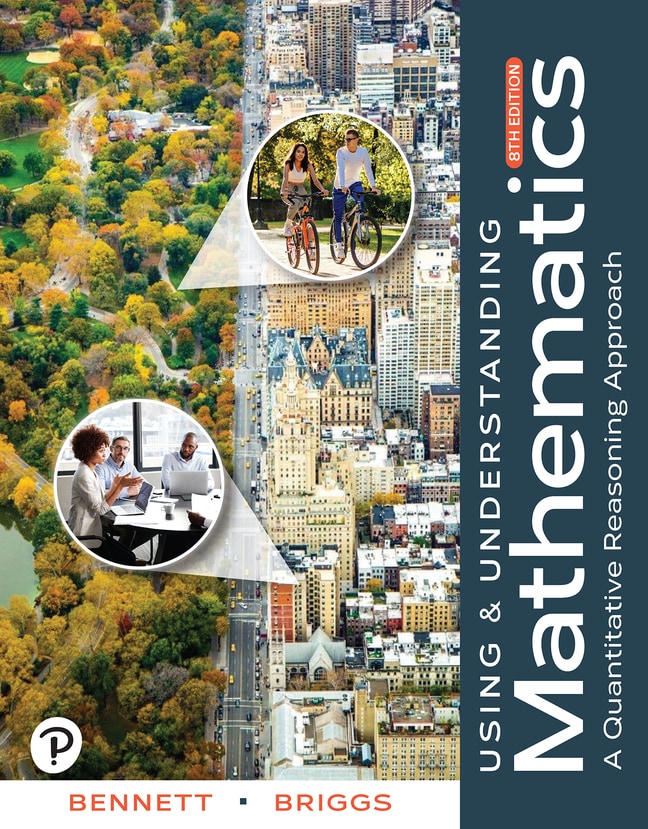
Using & Understanding Mathematics: A Quantitative Reasoning Approach, 8th edition
- Jeffrey O. Bennett
- , William L. Briggs

- Find it fast
Quickly navigate your eTextbook with search
- Stay organized
Access all your eTextbooks in one place
- Easily continue access
Keep learning with auto-renew
Using & Understanding Mathematics prepares you for the math you'll encounter in future courses, careers and daily life. Quantitative reasoning trailblazers Bennett and Briggs help foster the problem-solving tools needed to think critically about quantitative issues in society. Their content-driven approach is organized by mathematical ideas; after each topic is presented, examples of its applications are shown. The 8th Edition is extensively revised throughout, from the coronavirus pandemic to the latest presidential election and more.
Published by Pearson (July 7th 2022) - Copyright © 2023
ISBN-13: 9780137574971
Subject: Liberal Arts Math
Category: Quantitative Reasoning
I. LOGIC AND PROBLEM SOLVING
- GETTING STARTED: LITERACY FOR THE MODERN WORLD
- Activity: Job Satisfaction
- What is Quantitative Reasoning?
- Quantitative Reasoning and Culture
- Quantitative Reasoning in the Work Force
- Misconceptions About Mathematics
- What Is Mathematics?
- How to Succeed in Mathematics
- Thinking Critically
- Activity: Pandemic Math
- 1A. Living in the Media Age
- 1B. Propositions and Truth Values
- 1C. Sets and Venn Diagrams
- 1D. Analyzing Arguments
- 1E. Critical Thinking in Everyday Life
- Chapter 1 Summary
- Chapter 1 Review Questions
- Approaches to Problem Solving
- Activity: Global Melting
- 2A. Understand, Solve, and Explain
- Using Technology: Currency Exchange Rates
- 2B. Extending Unit Analysis
- Using Technology: Metric Conversions
- 2C. Problem-Solving Hints
- Chapter 2 Summary
- Chapter 2 Review Questions
II. QUANTITATIVE INFORMATION IN EVERYDAY LIFE
- Numbers in the Real World
- Activity: More Pandemic Math: Is 90% Good Enough?
- 3A. Uses and Abuses of Percentages
- 3B. Putting Numbers in Perspective
- Using Technology: Scientific Notation
- 3C. Dealing with Uncertainty
- Using Technology: Rounding in Excel
- 3D. Index Numbers: The CPI and Beyond
- 3E. Numerical Surprises: Polygraphs, Mammograms, and More
- Chapter 3 Summary
- Chapter 3 Review Questions
- Managing Money
- Activity: Student Loans
- 4A. Taking Control of Your Finances
- 4B. The Power of Compounding
- Using Technology: Powers
- Using Technology: The Compound Interest Formula
- Using Technology: The Compound Interest Formula for Interest Paid More Than Once a Year
- Using Technology: APY in Excel
- Using Technology: Powers of e
- 4C. Savings Plans and Investments
- Using Technology: The Savings Plan Formula
- Using Technology: Fractional Powers (Roots)
- 4D. Loan Payments, Credit Cards, and Mortgages
- Using Technology: The Loan Payment Formula (Installment Loans)
- Using Technology: Principal and Interest Portions of Loan Payments
- 4E. Income Taxes
- 4F. Understanding the Federal Budget
- Chapter 4 Summary
- Chapter 4 Review Questions
III. STATISTICS AND PROBABILITY
- Statistical Reasoning
- Activity: Cell Phones and Driving
- 5A. Fundamentals of Statistics
- Using Technology: Random Numbers
- 5B. Should You Believe a Statistical Study?
- 5C. Statistical Tables and Graphs
- Using Technology: Frequency Tables in Spreadsheets
- Using Technology: Bar Graphs and Pie Charts
- Using Technology: Line Charts
- 5D. Graphics in the Media
- Using Technology: Graphs with Multiple Data Sets
- 5E. Correlation and Causality
- Using Technology: Scatterplots
- Chapter 5 Summary
- Chapter 5 Review Questions
- Putting Statistics to Work
- Activity: Are We Smarter Than Our Parents?
- 6A. Characterizing Data
- Using Technology: Mean, Median, and Mode
- 6B. Measures of Variation
- Using Technology: Standard Deviation
- 6C. The Normal Distribution
- Using Technology: Standard Scores and Percentiles
- 6D. Statistical Inference
- Chapter 6 Summary
- Chapter 6 Review Questions
- Probability: Living With The Odds
- Activity: Lotteries
- 7A. Fundamentals of Probability
- 7B. Combining Probabilities
- 7C. The Law of Large Numbers
- 7D. Assessing Risk
- 7E. Counting and Probability
- Using Technology: Factorials
- Using Technology: Permutations
- Using Technology: Combinations
- Chapter 7 Summary
- Chapter 7 Review Questions
IV. MODELING
- Exponential Astonishment
- Activity: Towers of Hanoi
- 8A. Growth: Linear vs. Exponential
- 8B. Doubling Time and Half-Life
- Using Technology: Logarithms
- 8C. Real Population Growth
- 8D. Logarithmic Scales: Earthquakes, Sounds, and Acids
- Chapter 8 Summary
- Chapter 8 Review Questions
- Modeling Our World
- Activity: Climate Modeling
- 9A. Functions: The Building Blocks of Mathematical Models
- 9B. Linear Modeling
- Using Technology: Graphing Functions
- 9C. Exponential Modeling
- Chapter 9 Summary
- Chapter 9 Review Questions
- Modeling With Geometry
- Activity: Eyes in the Sky
- 10A. Fundamentals of Geometry
- 10B. Problem Solving with Geometry
- 10C. Fractal Geometry
- Chapter 10 Summary
- Chapter 10 Review Questions
V. FURTHER APPLICATIONS
- Mathematics and The Arts
- Activity: Digital Music Files
- 11A. Mathematics and Music
- 11B. Perspective and Symmetry
- 11C. Proportion and the Golden Ratio
- Chapter 11 Summary
- Chapter 11 Review Questions
- Mathematics and Politics
- Activity: Partisan Redistricting
- 12A. Voting: Does the Majority Always Rule?
- 12B. Theory of Voting
- 12C. Apportionment: The House of Representatives and Beyond
- 12D. Dividing the Political Pie
- Chapter 12 Summary
- Chapter 12 Review Questions
- Mathematics and Business (online only)
- 13A. Network Analysis
- 13B. The Traveling Salesperson Problem
- 13C. Scheduling Problems
- Chapter 13 Summary